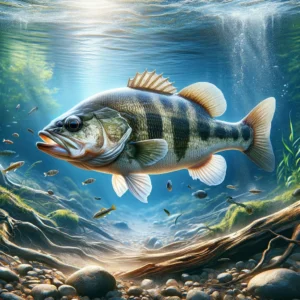Have you ever caught a 20 inch smallmouth bass while fishing? If so, have you ever wondered how old that fish might be? The age of fish can be a fascinating topic to explore, and in this article, we will delve into the age of smallmouth bass. You will learn about the factors that determine the age of these fish and the methods scientists use to estimate their age. By the end of this article, you will have a better understanding of just how old that impressive 20 inch smallmouth bass might really be.
Determining the age of a smallmouth bass can be quite complex, as it involves examining various factors. One of the primary methods used by scientists is to analyze the fish’s otoliths, also known as ear stones. These structures contain growth rings, similar to the rings in a tree trunk, which can provide insight into the age of the fish. Additionally, scientists may also use other methods such as scale samples or genetic analysis to estimate the age of smallmouth bass.
The age of a 20 inch smallmouth bass can vary depending on several factors. These factors include the habitat in which the fish lives, its diet, and even the genetics of the individual fish. In certain cases, a 20 inch smallmouth bass may be relatively young, perhaps only a few years old. However, in other cases, it could be much older, reaching an age of 10 years or more. The age of the fish can have implications for its reproductive capabilities and overall health.
In conclusion, the age of a 20 inch smallmouth bass can vary greatly depending on various factors. The analysis of otoliths, scale samples, and genetic analysis are all methods that scientists use to estimate the age of these fish. By understanding the age of smallmouth bass, we can gain insights into their life cycle and make informed decisions regarding their conservation and management. So next time you catch a 20 inch smallmouth bass, take a moment to appreciate just how long it might have been swimming in our waters.
Introduction
Smallmouth bass are a popular freshwater game fish native to North America. Known for their aggressive nature and spirited fights, smallmouth bass can provide an exciting challenge for anglers of all skill levels. In order to effectively catch and understand these remarkable fish, it is important to have knowledge of their lifecycle, growth patterns, behavior, and other factors that influence their overall well-being. This article aims to provide you with a comprehensive understanding of the age of smallmouth bass and offer insights into their complex world.
Lifecycle of Smallmouth Bass
Spawning
Smallmouth bass, like many other fish species, go through a reproductive process known as spawning. Typically occurring during the spring months when water temperatures reach around 60 to 65 degrees Fahrenheit, smallmouth bass migrate to shallow areas in lakes or rivers to breed. The male constructs a circular nest by clearing away debris, while the female deposits her eggs within the nest. After the eggs are laid, the male guards the nest until they hatch.
Egg Development
The eggs of smallmouth bass typically take anywhere from 7 to 15 days to hatch, depending on various factors such as water temperature and quality. During this time, the eggs are vulnerable to predation and environmental changes. It is important for the male to diligently guard and fan the eggs, as this helps to ensure their survival.
Larval Stage
Once hatched, the smallmouth bass enter the larval stage of their lifecycle. At this point, they are extremely small and rely heavily on their yolk sac for nourishment. They drift with the current, moving along river channels in search of suitable areas for growth and development.
Juvenile Stage
As the smallmouth bass continue to grow, they transition into the juvenile stage of their lifecycle. At this point, they develop a predatory appetite and begin actively feeding on small aquatic insects, zooplankton, and other small fish. During this stage, the smallmouth bass begin to establish their territories and develop their distinctive body shape and coloration.
Adult Stage
By the time smallmouth bass reach adulthood, usually around 3 to 4 years of age, they have reached their peak in terms of size and reproductive abilities. Smallmouth bass can grow to be anywhere between 12 to 27 inches in length, with the average size falling around 15 to 20 inches. They are known for their bronze coloration, vertical bars along their sides, and a large mouth equipped with sharp teeth for capturing prey.
Growth and Age Determination
Factors affecting growth
Several factors influence the growth of smallmouth bass, including genetics, availability of food, water temperature, and overall habitat quality. Smallmouth bass that inhabit lakes or reservoirs tend to have a higher growth rate compared to those in rivers due to the abundance of food resources. Additionally, smallmouth bass living in warmer waters generally experience faster growth compared to those in cooler climates.
Measuring smallmouth bass age
Determining the age of a smallmouth bass can be a challenging task. Unlike trees, fish do not have visible growth rings that can be counted to determine their age. Instead, scientists rely on various methods such as scale analysis and otolith examination. Scales can provide valuable information about the age and growth rate of a smallmouth bass, as they have annual rings that can be counted under a microscope. However, this method is not always accurate, especially for older fish. Otolith examinations, which involve analyzing the ear bones of the fish, provide a more reliable method for age determination.
How old is a 20-inch smallmouth bass?
While the age of a smallmouth bass can vary depending on several factors, a 20-inch smallmouth bass is generally estimated to be around 5 to 7 years old. This estimation is based on average growth rates and can provide a rough estimate of the age of the fish. It is important to note that individual growth rates can vary greatly, and factors such as food availability and habitat quality can significantly impact the growth rate of smallmouth bass.
Environmental Factors
Water temperature
Water temperature plays a crucial role in the overall health and development of smallmouth bass. These fish thrive in water temperatures ranging from 65 to 75 degrees Fahrenheit. As water temperature drops below or rises above this optimal range, smallmouth bass may become less active and their feeding habits may be affected. Extreme fluctuations in water temperature can also have detrimental effects on their reproductive capabilities.
Water quality
Smallmouth bass rely on clean and well-oxygenated water for their survival. Pollution, excessive nutrient runoff, and other forms of water contamination can have detrimental effects on their health and reproductive abilities. It is important to be mindful of the impact we have on the water quality of their habitats to ensure the long-term sustainability of smallmouth bass populations.
Diet and food availability
Smallmouth bass are opportunistic predators, meaning they will feed on a wide variety of prey depending on availability. Their diet primarily consists of small aquatic insects, crayfish, minnows, and other small fish. The abundance of food resources in their habitat directly affects their growth and overall health. Changes in food availability or the introduction of invasive species can disrupt the delicate balance of the ecosystem and impact the overall well-being of smallmouth bass populations.
Behavior and Adaptations
Feeding habits
Smallmouth bass are agile predators that primarily rely on their vision to locate and ambush prey. They are known for their voracious appetites and will readily strike at any suitable prey that comes within their striking distance. Smallmouth bass exhibit a preference for feeding during low-light conditions such as dawn and dusk, as their vision is optimized for low-light situations. They also utilize their lateral line system, which senses water movement and vibrations, to detect prey that may be hiding or swimming nearby.
Reproduction behavior
During the spawning season, smallmouth bass exhibit unique behaviors that are crucial for successful reproduction. The male constructs a nest using his tail, fins, and body movements, creating a depression in the sand or gravel substrate. The female then deposits her eggs within the nest, and the male fertilizes them externally. Once the eggs are fertilized, the male guards the nest from potential predators until the eggs hatch. This behavior ensures the survival of the offspring and contributes to the continued population of smallmouth bass.
Adaptations for survival
Smallmouth bass have evolved various adaptations to help them survive and thrive in their natural environments. Their streamlined body shape allows for efficient movement through the water, enabling them to chase and capture prey with ease. Their large mouth and sharp teeth are perfectly suited for grasping and holding onto their prey. Additionally, smallmouth bass possess a camouflage coloration that blends in with their surroundings, providing them with a slight advantage when hunting or avoiding predators.
Threats and Conservation
Human impacts
Smallmouth bass populations face numerous threats as a result of human activities. Habitat destruction and alteration, such as the construction of dams and the draining of wetlands, can greatly impact the availability of suitable spawning areas and food resources. Pollution from industrial and agricultural activities can also have detrimental effects on water quality, potentially leading to the decline of smallmouth bass populations.
Invasive species
The introduction of non-native fish species can greatly disrupt the balance of the ecosystem and pose a significant threat to smallmouth bass populations. Invasive species such as the round goby and zebra mussels compete with smallmouth bass for food resources and can also introduce diseases or parasites that can negatively impact their health.
Conservation efforts
Efforts to protect and conserve smallmouth bass populations have been implemented by government agencies, conservation organizations, and recreational fishing communities. These efforts include habitat restoration projects, water quality improvement initiatives, and the establishment of fishing regulations to ensure the sustainable management of smallmouth bass populations. It is crucial for anglers and recreational fishermen to practice responsible fishing techniques and support conservation efforts to help preserve and protect this valuable species.
Fishing Regulations
Size and bag limits
To ensure the sustainability of smallmouth bass populations, fishing regulations have been established in many jurisdictions. These regulations often include size limits, which specify the minimum length at which a smallmouth bass can be legally harvested. Bag limits may also be in place, which restrict the number of smallmouth bass that can be kept per day. These regulations aim to protect smaller individuals, which are important for the overall reproductive success and long-term viability of the population.
Fishing seasons
Many areas have specific fishing seasons for smallmouth bass, during which anglers are allowed to target and harvest these fish. Fishing seasons are typically determined based on the spawning behavior and lifecycle of smallmouth bass, ensuring that there is minimal disturbance to their reproductive activities. It is important to check local fishing regulations and adhere to any specific fishing season restrictions in order to promote sustainable fishing practices.
Catch and release practices
Catch and release practices have become increasingly popular among recreational anglers who wish to preserve smallmouth bass populations and contribute to their conservation. Catch and release involves carefully handling and returning caught fish back to the water unharmed. This practice helps to maintain healthy population levels, allows fish to reach their maximum growth potential, and promotes the sustainability of smallmouth bass for future generations of anglers to enjoy.
Recreational Fishing Tips
Best fishing techniques
When targeting smallmouth bass, there are several effective fishing techniques to increase your chances of success. Casting crankbaits, soft plastic worms, or spinnerbaits near underwater structure such as rocks, fallen trees, or weed beds can entice smallmouth bass to strike. Topwater lures, such as poppers or buzzbaits, can also be effective during low-light conditions or when smallmouth bass are actively feeding near the surface. Experimenting with different retrieval speeds, depths, and lure colors can help fine-tune your technique and increase your catch rate.
Preferred bait and lures
Smallmouth bass are known to be aggressive feeders and will strike at a variety of baits and lures. Live bait options such as minnows, crayfish, or worms can be effective when targeting smallmouth bass. Artificial lures such as jigs, plastic worms, crankbaits, and spinnerbaits are also popular choices among anglers. The best bait or lure to use often depends on the specific conditions and the preferences of the fish on any given day. It is important to experiment with different options and adapt your approach to maximize your chances of success.
Fishing equipment recommendations
When fishing for smallmouth bass, it is essential to have the right equipment to handle their size and fight. A medium to medium-heavy spinning or baitcasting rod with a fast action is recommended for optimal control and sensitivity. Pairing the rod with a quality reel that has a smooth drag system will help you land and control the fish effectively. It is also important to use appropriate test line, typically ranging from 8 to 12 pounds, to handle the aggressive strikes and fighting abilities of smallmouth bass.
Smallmouth Bass vs. Largemouth Bass
Physical differences
Smallmouth bass and largemouth bass are two closely related species with several distinct physical differences. The most noticeable difference is the size of their mouths. Smallmouth bass have smaller mouths, which do not extend beyond the back of the eye. Largemouth bass, on the other hand, have larger mouths that extend well beyond the back of the eye. Additionally, smallmouth bass have vertical bars along their sides, whereas largemouth bass have a lateral line that curves upwards towards their tails.
Behavioral differences
While both smallmouth bass and largemouth bass exhibit similar predatory behaviors, they do have some behavioral differences. Smallmouth bass are known for their aggressive and energetic fighting abilities, often putting up a spirited fight when hooked. Largemouth bass, although also capable of putting up a strong fight, tend to be more sluggish and less acrobatic compared to smallmouth bass. Understanding these behavioral differences can help anglers in selecting the appropriate techniques and strategies when targeting these species.
Preferred habitats
Smallmouth bass and largemouth bass have different habitat preferences, although there is some overlap. Smallmouth bass tend to inhabit clear and cool waters, often found in rocky areas of lakes, rivers, and reservoirs. They are known for their affinity to structure such as rocks, fallen trees, and submerged vegetation. Largemouth bass, on the other hand, prefer warm and murky waters with abundant vegetation such as lily pads, submerged grass, or weed beds. It is important to consider the habitat preferences of each species when planning a fishing trip.
Conclusion
In conclusion, understanding the age of smallmouth bass is crucial for gaining insights into their lifecycle, behavior, and overall well-being. From their spawning and larval stages to their growth patterns and feeding habits, smallmouth bass have unique characteristics that make them fascinating subjects of study. By considering the environmental factors that influence their health and the threats they face, we can work towards preserving and conserving smallmouth bass populations for future generations of anglers to enjoy. By adhering to fishing regulations, practicing catch and release, and adopting responsible fishing techniques, we can contribute to the long-term sustainability of these remarkable fish. So, the next time you find yourself on the water, take a moment to appreciate the age and complexity of the smallmouth bass swimming beneath the surface.




